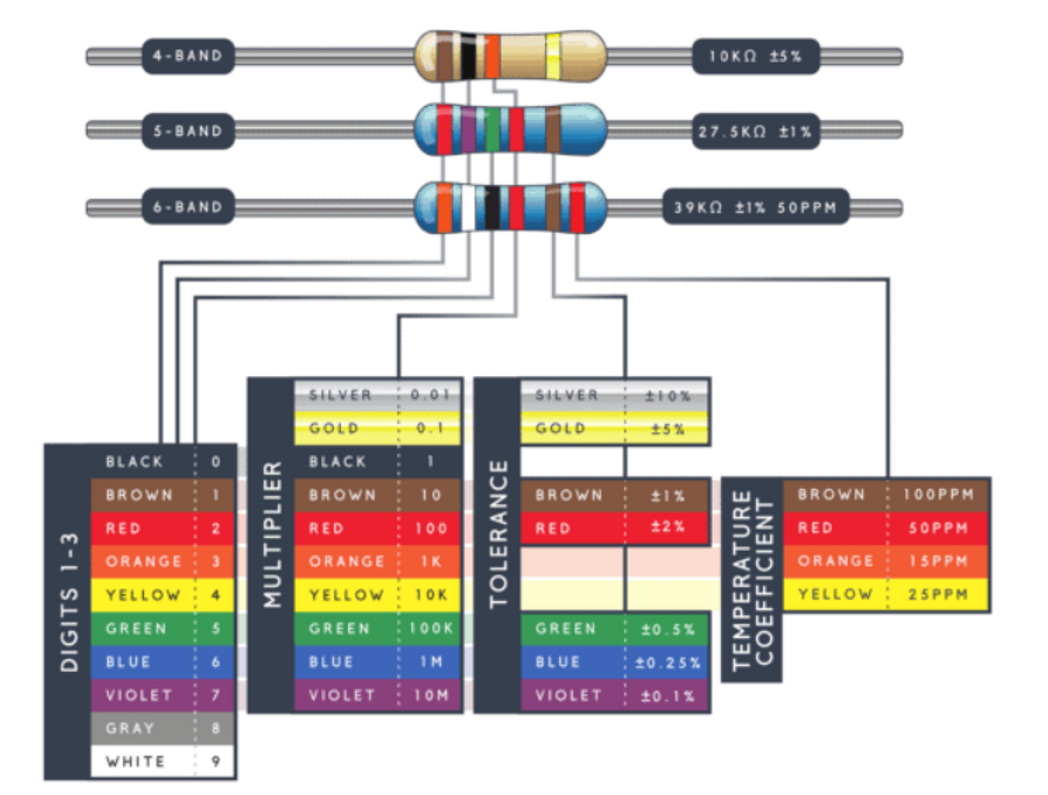What is a resistor? How does a resistor work? What does a resistor do?
Before we can answer that we need to know:
What is resistance?
V=I×R
V is Voltage measure in volts (written as V)
I is Current measured in amps (written as A)
R is Resistance measure in ohms (written as Ω)
This is known as Ohm’s Law after German Scientist Georg Simon Ohm.
So what is a resistor?
A resistor is an electronic component that resists the flow of electrons in a circuit. Almost all of the time when talking about resistors people mean fixed resistors that have a known static resistance. Static resistors are passive components i.e. they only consume power. In-circuit diagrams, resistors show up either as a rectangle following the international standard or as a squiggle which is the American version. In the rest of this article, we will refer to static resistors as just resistors.

Left: 100 ohm American style resistor. Right: 200 ohm international standard resistor.
How does a resistor work?
A resistor works by restricting the flow of current, it can do this in one of three ways: firstly, by using a less conductive material, secondly by making the conductive material thinner and finally by making the conductive material longer. A lot of resistors are wire-wound, as the name suggests they consist of a conductive wire wound around an insulating middle, with other resistors rather than a physical wire wound around, it’s just a spiral of carbon, these are called carbon-film. Wire-wound resistors are more precise and stable than carbon-film resistors, the resistance of the resistor is controlled by the number of turns and thickness of the wire. There are many types of resistors but they all function on the same three principles as this is the only reliable way to control the resistance of the resistors.

Current can be thought of like water flowing through a pipe. Resistance would be how easy it is for that water to flow. On the left is a more ‘conductive’ pipe as it is wider it allows more electrons through and therefore has a larger current. On the right is a less ‘conductive’ pipe as it is thinner it allows less electrons through and therefore has a smaller current.

A carbon film resistor with most of its protective casing taken off. You can clearly see the carbon spiral that gives the resistor its resistance.
What does a resistor do?
A resistor limits current and drops the voltage. Simple, but very useful. In a very simple and standard example seen below:

With a 12 volt d.c. supply we want to drive a 3 volt LED. Without a current limiting resistor the LED will very quickly burn. So we add a resistor, but what value should the resistor have?
Well we know that the circuit has 12 volts being supplied to it, and that 3 volts are being used by the LED, so that leaves 9 volts for the resistor. We also know that the circuit has to have a current of about 20 milliamps (0.02 amps) otherwise the LED will burn out.
We can use Ohm’s Law to find the resistor R needed to protect the LED from excessive current.
V = I×R (Ohm’s Law)
9 = 0.02×R (substitute in the values)
R = 9÷0.02 (rearrange the equation)
R = 450 Ω (the resistance required
Using Ohm’s Law we have worked out we will need a 450 ohm resistor for our LED. This resistor is a current limiting resistor which is a very common use for resistors. Other common uses include voltage dividers and pull up resistors.
What do the markings on resistors mean?
Resistor markings come in three types, 4, 5 or 6 banded. With 4 banded resistors the first two bands tell you digits the third band tells you the multiplier and the fourth band tells you the tolerance (which is how variable the actual resistance value from the stated one will be). With 5 banded resistors the first three bands tells you digits, the fourth band tells you multipliers and the fifth band tells you tolerances. 6 banded resistors have the same first 5 bands as a 5 banded resistor does, then the sixth band tells you the temperature coefficient (which is how much the resistance value will vary with temperature measured in ppm per ºC (ppm stands for parts per million)).

Recent Posts
-
What is Ohm's Law?
Are you curious about how electricity works? Let me introduce you to a very important concept i …9th Mar 2023 -
How do I control a central heating system using an Arduino
To control a heating system using an Arduino, you will need to write a sketch (program) that impleme …7th Feb 2023 -
The Versatility of Slotted Aluminium Extrusions: From Robotics to Camper Van Renovations
In today's ever-evolving world, the need for versatile and adaptable building materials is greater t …25th Jan 2023




